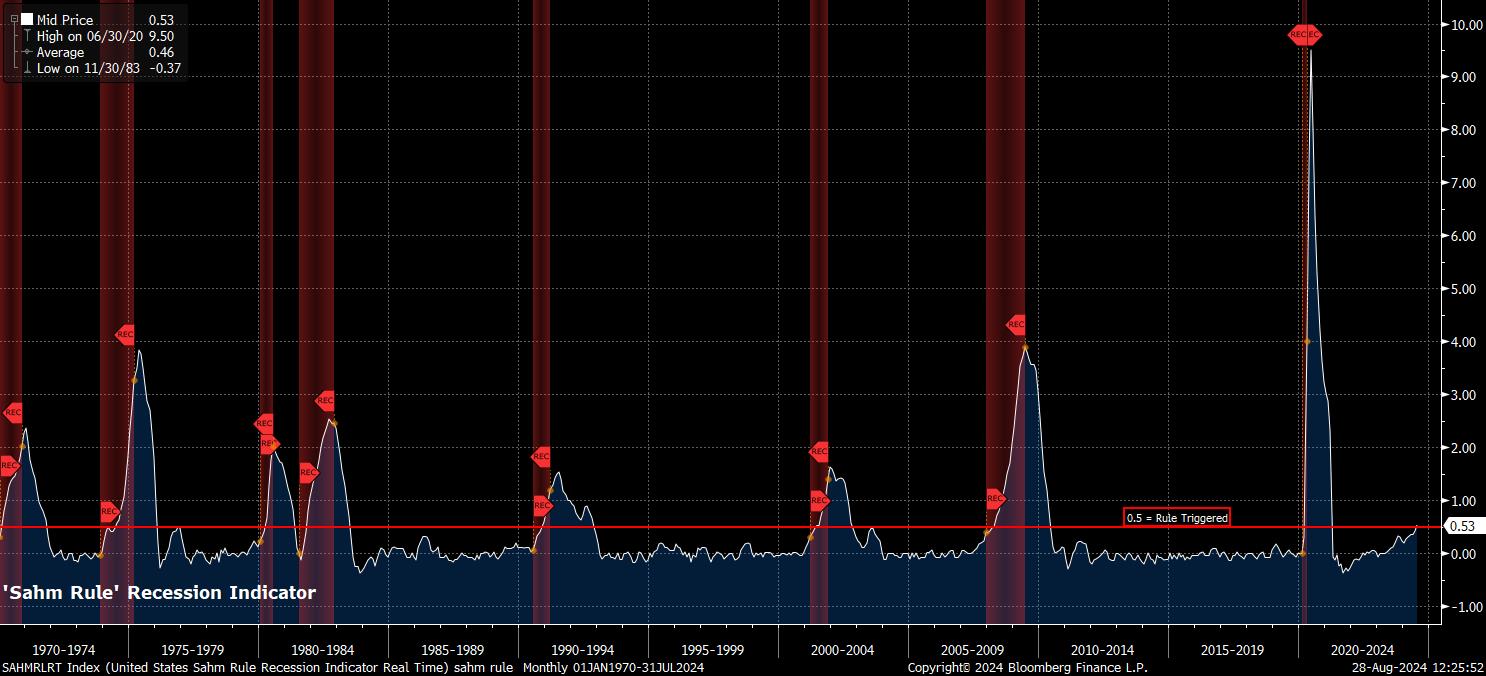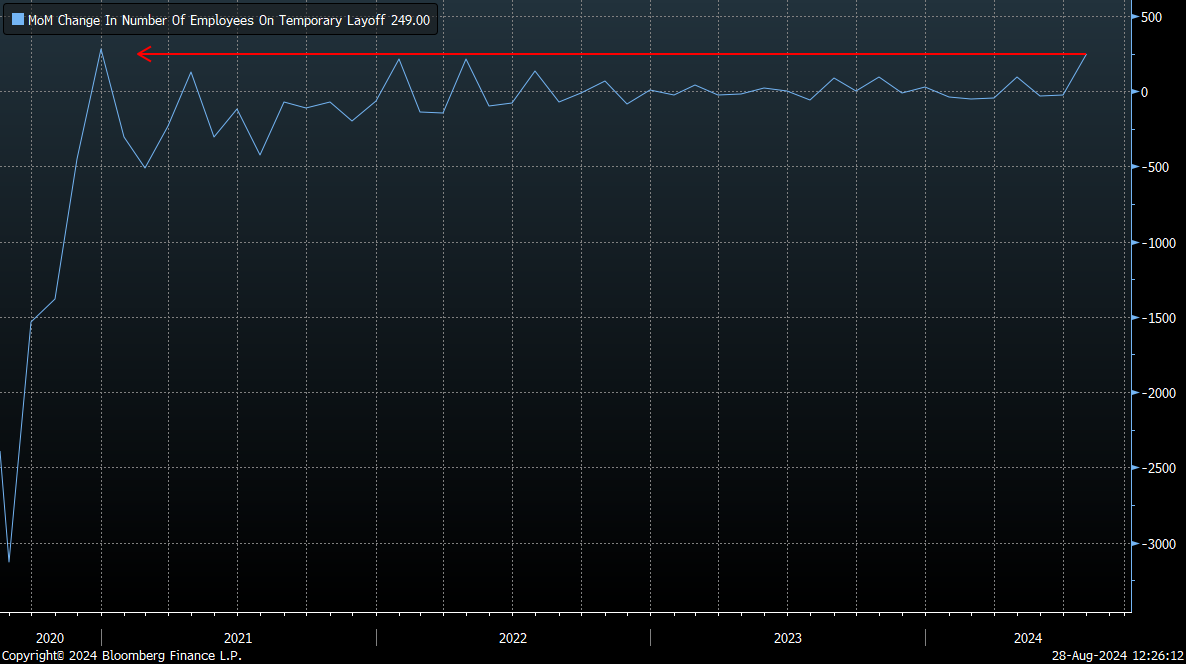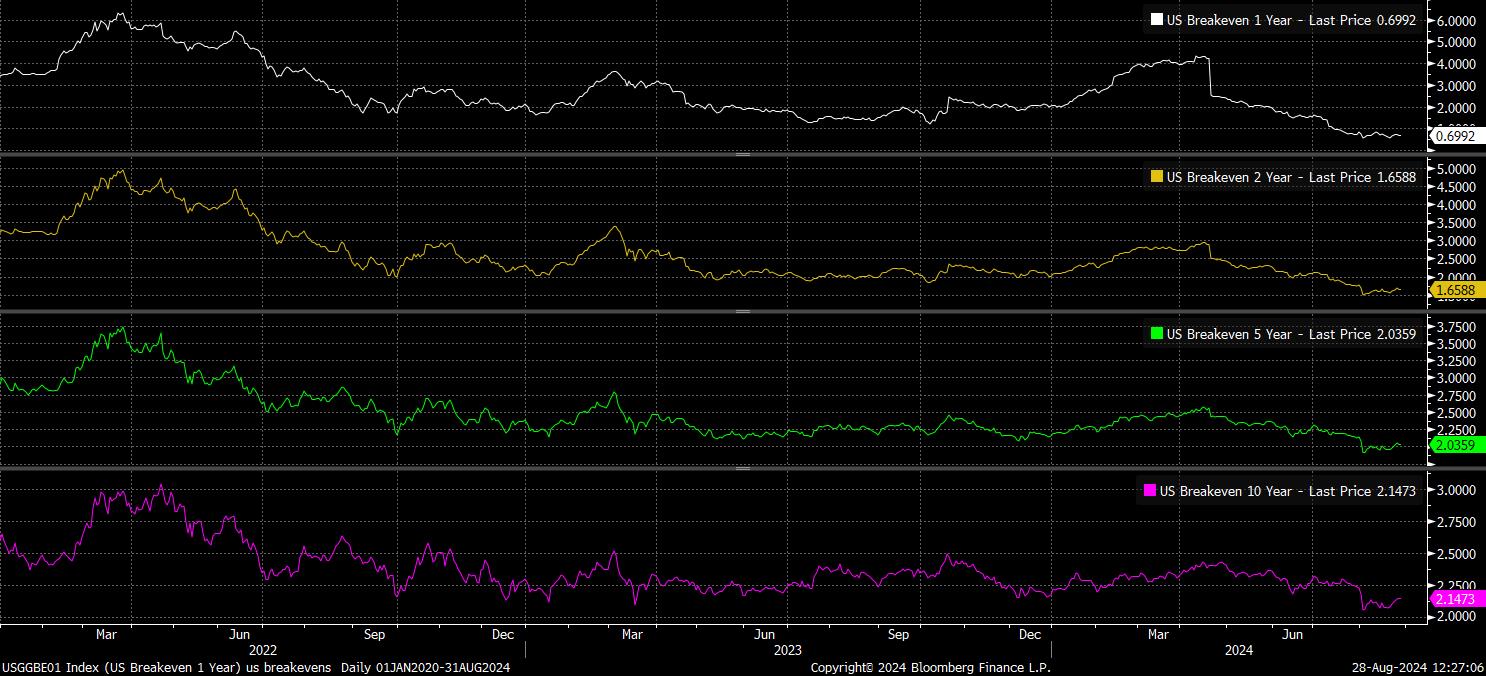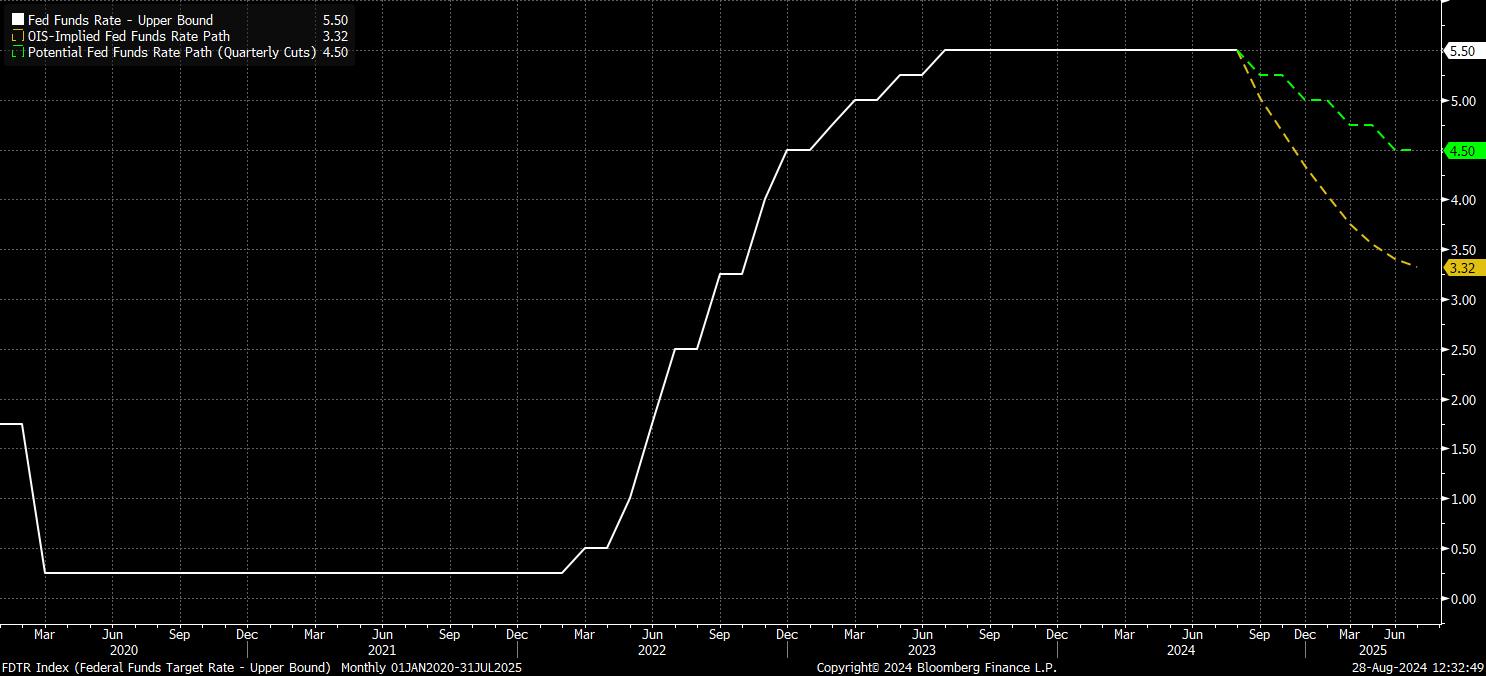Share
犀利的观察者在眼下浏览市场时很可能会感到一种强烈的似曾相识。再次出现了一个市场对近期货币政策宽松前景过于兴奋的情形,尤其是对于美联储,市场定价似乎过于迅速,过于深入地规范化路径。
开始的最佳地点自然是看看市场目前的定价。市场普遍认为9月份的25bp联邦基金利率降息是确定的,而50bp的较大幅度调整被认为有大约四分之一的几率。在更远的未来,美元OIS曲线预计到年底将下调超过100bp;考虑到2024年只有三次FOMC会议,这种定价暗示至少其中一次会议将看到鲍威尔等人推出50bp的降息。此外,市场预计明年初将快速放缓,曲线预计到2025年上半年底将下调近200bp,有效地判断利率将在不到一年内回到中性水平。
这样的路径看起来过于乐观。尽管如此,正如下文清楚展示的那样,我们以前也曾经历过这种情况,市场参与者在试图猜测货币政策路径方面的记录令人震惊。
这样的路径看起来过于乐观。尽管如此,正如下文清楚展示的那样,我们以前也曾经历过这种情况,市场参与者在试图猜测货币政策路径方面的记录令人震惊。
Preview
当前市场定价代表了美联储(FOMC)要达到的非常高标准,这使一些资产容易受到最近趋势逆转的影响,特别是在外汇领域。从劳动力市场来看,这是第一个原因。尽管7月的就业报告无疑显示就业状况进一步放缓,但并非灾难。过去3个月的平均薪资增长率为+170k,是三年来最低的水平,尽管与2018年和2019年上一轮经济周期后期的增长速度相似。同时,失业率也引起了极大关注,头条失业率已经上升到4.3%,是自2021年第四季度以来的最高水平,同时触发了所谓的“Sahm Rule”衰退指标。然而,这背后还有更多内容。

Preview
首先,最近几个月失业率上升,同时劳动力参与率也在增加,这意味着至少有一部分上升并非是因为失业人数增加,而是劳动力规模增加了。实际上,这是一个积极的迹象,因为更多的人正在进入劳动力市场寻找工作。
其次,7月份失业率的上升看起来越来越反常。头条失业率上升的很大程度上是由临时性裁员激增驱动的,上个月增加了249k,是自2020年末以来的最大环比增长。这几乎完全是由飓风贝丽尔的影响造成的,该飓风在调查周期间袭击,导致许多人在恶劣天气中无法工作。此外,最近几周初次和继续失业救济申请人数有所下降,进一步支持了一个观点,即7月份的失业率上升在9月6日发布的8月就业报告时将会逆转。
其次,7月份失业率的上升看起来越来越反常。头条失业率上升的很大程度上是由临时性裁员激增驱动的,上个月增加了249k,是自2020年末以来的最大环比增长。这几乎完全是由飓风贝丽尔的影响造成的,该飓风在调查周期间袭击,导致许多人在恶劣天气中无法工作。此外,最近几周初次和继续失业救济申请人数有所下降,进一步支持了一个观点,即7月份的失业率上升在9月6日发布的8月就业报告时将会逆转。

Preview
简而言之,美国劳动力市场并不像上一个就业报告所暗示的那样软弱。
然而,不仅仅是就业市场表明市场对美联储政策前景的定价过于激进。
通胀背景也表明仍然需要保持一定程度的谨慎,即使鲍威尔主席在杰克逊霍尔确认决策者们终于获得了足够的信心,即通胀率正朝着2%回升的路径上。
然而,“朝着”2%并不意味着已经实现了2%的目标,也不保证目标会在中期内可持续实现,因为美联储的双重 mandate 要求实现这一目标。服务价格仍然顽固上涨,在7月份同比上涨近5%,同时,通胀风险也来自其他几个方面。
小时工资增长继续放缓,尽管7月份同比增长3.6%,仍代表了健康的实际收入增长速度。如果劳动力市场再次收紧,工资压力再次出现,这可能威胁到实现通胀目标的可持续性。与此同时,地缘政治风险仍然存在,中东地区的局势仍然不稳定,如果情势进一步恶化,可能会导致原油价格激增。尽管决策者可能会忽略这种暂时性增长,但这可能仍然会使消费者和市场的通胀预期朝上偏斜。
然而,不仅仅是就业市场表明市场对美联储政策前景的定价过于激进。
通胀背景也表明仍然需要保持一定程度的谨慎,即使鲍威尔主席在杰克逊霍尔确认决策者们终于获得了足够的信心,即通胀率正朝着2%回升的路径上。
然而,“朝着”2%并不意味着已经实现了2%的目标,也不保证目标会在中期内可持续实现,因为美联储的双重 mandate 要求实现这一目标。服务价格仍然顽固上涨,在7月份同比上涨近5%,同时,通胀风险也来自其他几个方面。
小时工资增长继续放缓,尽管7月份同比增长3.6%,仍代表了健康的实际收入增长速度。如果劳动力市场再次收紧,工资压力再次出现,这可能威胁到实现通胀目标的可持续性。与此同时,地缘政治风险仍然存在,中东地区的局势仍然不稳定,如果情势进一步恶化,可能会导致原油价格激增。尽管决策者可能会忽略这种暂时性增长,但这可能仍然会使消费者和市场的通胀预期朝上偏斜。

Preview
最后,有人认为目前经济根本不需要降息。快速查看增长背景就足以支持这种观点,过去八个季度中有七个季度的GDP以年率计算增长超过2%,这在任何人看来都是一个稳健的增长速度。同时,领先指标表明这种韧性将继续存在 - 7月份总零售销售同比增长1.0%,而ISM服务业PMI保持在扩张区域。

Preview
7月劳动力市场放缓的异常性质,通胀前景的持续风险,以及仍然稳健的经济增长,都表明市场对降息定价过于雄心勃勃,幅度显著。当然,这也应该与FOMC小心翼翼的天性相结合,避免造成不必要的不确定性或恐慌,这也表明至少在一开始时,决策者们会相对渐进地回到更加中性的政策立场。
这很可能会采取每季度25个基点的降息形式,至少在今年。
这很可能会采取每季度25个基点的降息形式,至少在今年。

Preview
所有这些都引出了一个问题,即当前过于激进的市场定价以及潜在的重新定价可能会产生什么影响:
对于美元来说,如果美联储政策预期重新定价变得鹰派,可能受到8月份就业报告好于预期的刺激,将有助于美元从鲍威尔主席杰克逊霍尔讲话后创下的年初低点中反弹。鉴于进一步鸽派重新定价的门槛较高,以及推动市场运作的“买增长”主题在全球十大经济体中都支持美元而不是同行,美元的风险偏向上行。
在金融投资领域,尽管迹象表明本周的供应可能会相对容易吸收,但前端国债仍然容易逆转,这可能进一步提高美元的上行风险。然而,长端似乎在目前水平上定价合理,特别是考虑到通胀可能需要更长时间才能回到2%的目标。
国债市场的重新抛售也可能威胁到黄金,因为这种黄金最近的上涨在接近创下新纪录高点时就停滞了。然而,今年黄金几乎没有展示出与其“传统”基本面驱动因素的密切关系,支持性的新兴市场央行资金流提供了有力的推动力。
最后,在股票市场中,鹰派的美联储重新定价不应该是一个重大的负面催化剂。与2024年的其余时间一样,驱动股市的关键因素不是美联储会做什么,而是美联储可以做什么。这就是“美联储保护”的本质 - 如果情况恶化,美联储有能力更明显地、更迅速地或两者兼而有之地削减利率,以提供必要的支持。了解鲍威尔等人“有后盾”,并且有足够的空间来削减如果需要的话,应该会让参与者继续放心地留在风险曲线的更远端,使股票的疲软短暂,并将跌幅视为买入机会。
对于美元来说,如果美联储政策预期重新定价变得鹰派,可能受到8月份就业报告好于预期的刺激,将有助于美元从鲍威尔主席杰克逊霍尔讲话后创下的年初低点中反弹。鉴于进一步鸽派重新定价的门槛较高,以及推动市场运作的“买增长”主题在全球十大经济体中都支持美元而不是同行,美元的风险偏向上行。
在金融投资领域,尽管迹象表明本周的供应可能会相对容易吸收,但前端国债仍然容易逆转,这可能进一步提高美元的上行风险。然而,长端似乎在目前水平上定价合理,特别是考虑到通胀可能需要更长时间才能回到2%的目标。
国债市场的重新抛售也可能威胁到黄金,因为这种黄金最近的上涨在接近创下新纪录高点时就停滞了。然而,今年黄金几乎没有展示出与其“传统”基本面驱动因素的密切关系,支持性的新兴市场央行资金流提供了有力的推动力。
最后,在股票市场中,鹰派的美联储重新定价不应该是一个重大的负面催化剂。与2024年的其余时间一样,驱动股市的关键因素不是美联储会做什么,而是美联储可以做什么。这就是“美联储保护”的本质 - 如果情况恶化,美联储有能力更明显地、更迅速地或两者兼而有之地削减利率,以提供必要的支持。了解鲍威尔等人“有后盾”,并且有足够的空间来削减如果需要的话,应该会让参与者继续放心地留在风险曲线的更远端,使股票的疲软短暂,并将跌幅视为买入机会。
Related articles
这里提供的材料并未根据旨在促进投资研究独立性的法律要求进行准备,因此被视为营销沟通。尽管不受任何关于在投资研究传播之前进行交易的禁令,我们不会在向客户提供信息之前寻求任何利益。
Pepperstone不保证这里提供的材料准确、最新或完整,因此不应依赖这些信息。这些信息,无论来自第三方与否,不应被视为推荐;或者买卖的要约;或者购买或出售任何证券、金融产品或工具的邀约;或者参与任何特定的交易策略。它不考虑读者的财务状况或投资目标。我们建议阅读此内容的任何读者寻求自己的建议。未经Pepperstone批准,不得转载或重新分发这些信息。
Pepperstone不保证这里提供的材料准确、最新或完整,因此不应依赖这些信息。这些信息,无论来自第三方与否,不应被视为推荐;或者买卖的要约;或者购买或出售任何证券、金融产品或工具的邀约;或者参与任何特定的交易策略。它不考虑读者的财务状况或投资目标。我们建议阅读此内容的任何读者寻求自己的建议。未经Pepperstone批准,不得转载或重新分发这些信息。


.jpg?height=420)